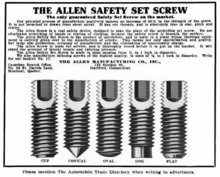Set screw


In American English, a set screw is a screw that is used to secure an object, by pressure and/or friction, within or against another object, such as fixing a pulley or gear to a shaft.[1][2] A set screw is normally used without a nut (which distinguishes it from a bolt), being screwed instead in a threaded hole drilled in only one of the two objects to be secured. A set screw is often headless and threaded along its entire length, so that it will sit entirely inside that hole; in which case it may be called a grub screw or blind screw.
Once fully and firmly screwed into the first object, the projecting tip of the set screw presses hard against the second object, acting like a clamp. The second object may have a machined detent (recess) to ensure that it cannot slide under the tip of the screw. On a shaft, this may be simply a flattened area. A set screw may have any type of drive, such as hex or square head, slot, or recessed --- cross (Phillips), hex (Allen), star (Torx), or square (Robertson).
In the
Torque resistance or transmission

Set screws are not always the best way to resist the
For longer life, set screws are usually made of
Point types

Set screws appear with a variety of tip (point) types. The different shaped tips have different properties that engineers can utilize. If an engineer were to use a detent to ensure proper nesting of the screw, they might choose to use a cone point type of screw. One might often need to use a flat point when the screw must press perfectly flat against a surface. The most common type is the cup point. This type works well because the surface is rounded so that a small surface area is in contact, but it does not have extremely high stress at one point like that of a cone point. Durability studies show that the cup point offers superior resistance to wear while maintaining a strong grip.[3] Knurled cup points offer the added advantage of a locking action (similar to that of a serrated lock washer) that prevents the screws from working loose in high-vibration applications.[4]
Common points include the following:
- Flat point
- Domed point
- Cone point
- Cup point
- Extended point (pilot point, dog point)
- Knurled cup point
Knurled cup point
Knurl point screws are generally used to secure one object within another. The serrated ridge on the knurl cup set screw helps reduce loosening due to vibration. The knurled point combines digging action of the cup point with counter-clockwise locking knurls that have a ratchet-locking action which helps resist loosening, even under the most severe vibrations.[5][6]
Knurl point set screws should not be reused because the cutting edges of the knurls are deflected when tightened. During removal, the cutting edges are torn and no longer have full strength to resist unscrewing. ISO standard for Knurled cup point set screw is ISO 4029.
Drive types
Set screws are made with a variety of drive styles, including the following:
History
The concept of set screws is centuries old, predating the metal screw by at least several hundred years. Early materials included wood, bone, horn, antler and ivory.
Headless set screws have been around for a long time, with the
See also
References
- ^ a b "Set Screw Supplier - Bulk Set Screws - AFT Fasteners". www.aftfasteners.com. AFT. Retrieved 24 July 2019.
- ^ a b "Bolt & Setscrew Information". Leyton Fasteners. Retrieved 2019-11-06.
- ^ Kent. (1895). The mechanical engineer's pocket-book. P.978.
- ^ Hallowell 1951, pp. 59–61
- ^ Fastenal Company
- ^ KD Fasteners, Inc.
- ^ Hallowell 1951, p. 51.
Bibliography
- Hallowell Sr., Howard Thomas (1951), How a Farm Boy Built a Successful Corporation: An Autobiography, Jenkintown, Pennsylvania, USA: Standard Pressed Steel Company, OCLC 521866.
External links
- Page illustrating various set screw tip types - Dead link.
